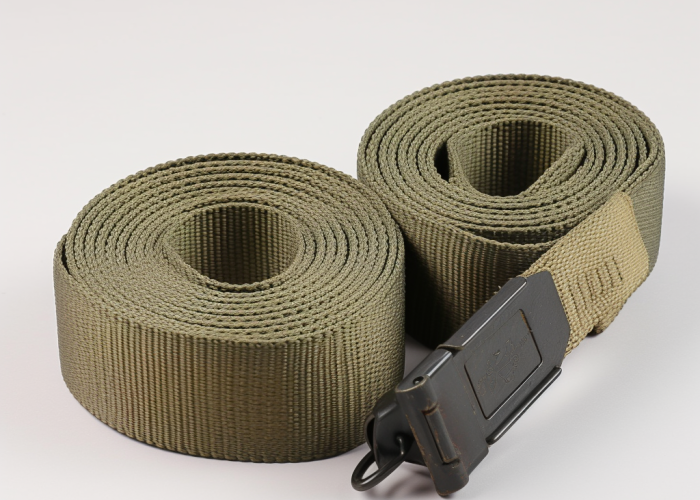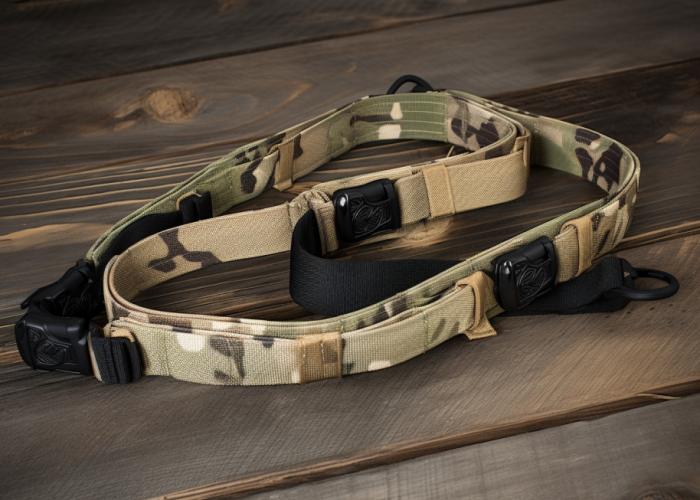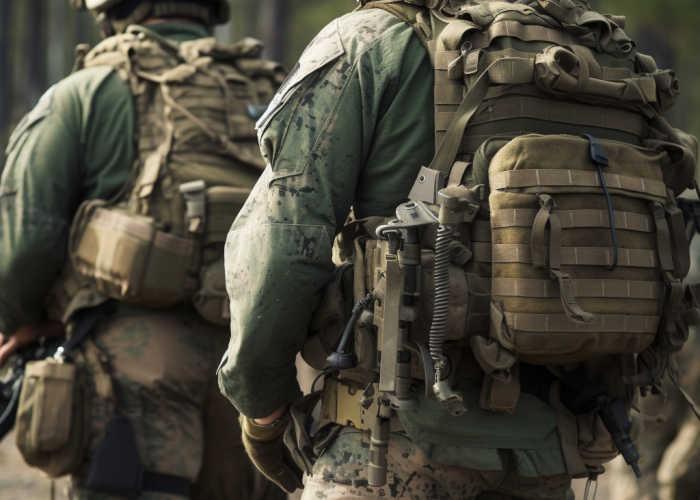As a custom webbing manufacturer, we regularly field questions from product developers struggling to specify the right military-grade webbing for their applications. Many face confusion about strength requirements, material selection, and compliance standards—often leading to costly specification mistakes or over-engineered solutions. We’re writing this guide to help engineers and designers make informed decisions about military webbing specifications, drawing from our manufacturing expertise in creating tailor-made solutions for demanding applications.
Military webbing is high-strength woven material made from nylon, polyester, Kevlar, or Nomex, designed to meet Mil-Spec standards for tactical and load-bearing use. It supports 2,000–10,000 lbs, resists fire and water, and withstands harsh environments for safety-critical military gear.
Discover how to select the right military webbing with expert insights on materials, compliance, and design—backed by proven manufacturing experience.


Webbing manufacturing expert with 15+ years of experience helping product developers build high-performance straps for industrial, medical, and outdoor use.
Military webbing serves critical roles in tactical vests, parachute harnesses, climbing gear, and body armor systems where structural failure is not an option. These applications demand materials engineered to withstand dynamic loading, environmental extremes, and repeated stress cycles while maintaining safety margins essential for life-critical operations.
Key Performance Requirements:
MOLLE systems utilize PALS webbing for attaching ammunition pouches, gas masks, grenades, and communication devices, requiring breaking strengths of 4,000+ pounds for 1-inch widths. Parachute applications using Mil-T 87130 Kevlar webbing must withstand shock loads 3-5 times normal operational forces during emergency deployments . Military-grade webbing maintains 85-90% strength retention after 10,000 flex cycles, compared to 60-70% for commercial alternatives.
From our manufacturing perspective, tactical vest failures typically occur at attachment points where inadequate webbing specifications meet high-stress mounting hardware. We’ve observed that selecting commercial-grade webbing for military applications increases failure rates by 300-400% in field conditions where equipment failure can result in mission compromise or personnel injury.
Military applications require compliance with Mil-Spec standards including MIL-W-4088 for general webbing, MIL-T-87130 for Kevlar applications, and PIA specifications for parachute systems. These standards mandate specific material compositions, weave patterns, and performance thresholds that cannot be substituted with commercial equivalents.
Design Takeaway: When specifying military webbing, tactical gear requires MOLLE-compatible 1-inch webbing with minimum 4,000-pound breaking strength, while parachute applications demand Kevlar construction meeting Mil-T 87130 standards. Always incorporate safety factors of 4:1 to 6:1 for life-critical applications and verify military specification compliance during design validation—commercial webbing alternatives compromise both performance and safety in demanding operational environments.
Nylon provides the optimal balance of strength, durability, and cost-effectiveness for most military webbing applications, while Kevlar offers superior performance for extreme-duty requirements like parachute systems. Polyester excels in UV-resistant outdoor applications, and Nomex serves specialized fire-resistant needs. Material selection depends on specific performance requirements, environmental conditions, and budget constraints
Material Performance Specifications:
Nylon and Kevlar represent the most common military webbing materials, with Kevlar offering superior strength but at significantly higher cost. Polyester webbing provides 90% of nylon’s durability while offering superior UV stability and water resistance, making it ideal for extended outdoor applications. Kevlar webbing delivers exceptional tensile strength and heat resistance but can lose up to 50% strength after just 40 hours of UV exposure, requiring careful application consideration.
From our manufacturing experience, 60% of military webbing orders specify nylon due to its optimal strength-to-cost ratio for tactical vests and general equipment. Kevlar applications typically focus on parachute systems where weight savings justify the 3-5x cost premium, while polyester serves outdoor equipment requiring UV resistance. Material selection errors often occur when customers specify Kevlar for UV-exposed applications or choose standard nylon for high-heat environments.
Military-grade treatments include fire retardancy, water repellency, and IR-reflective coatings that enhance base material properties without compromising strength. Treatment selection must align with material characteristics—nylon accepts most coatings readily, while Kevlar requires specialized treatments to maintain performance.
Design Takeaway: Choose nylon for general military applications requiring 4,000-6,500 lb breaking strength where cost-effectiveness matters most. Specify Kevlar only for weight-critical, heat-resistant applications like parachute harnesses, accepting UV limitations. Select polyester for outdoor equipment requiring UV stability. Always verify material-treatment compatibility during specification—incompatible combinations reduce performance by 30-50%.

Military webbing breaking strength ranges from 2,000 pounds for 1/2-inch widths to 10,000+ pounds for 2-inch polyester webbing, with standard 1-inch nylon webbing typically rated at 4,000-6,500 pounds. Actual strength depends on material type, width, weave pattern, and manufacturing specifications, with safety factors of 4:1 to 6:1 required for life-critical applications
Breaking Strength Specifications:
Standard 1-inch military nylon webbing provides 4,000 pounds breaking strength under controlled laboratory conditions with proper testing protocols. Breaking strength testing involves mounting webbing samples in certified test fixtures and gradually increasing tensile force until failure occurs. Real-world performance data shows that knots can reduce webbing strength by 20-50% depending on knot type, while environmental factors like UV exposure, chemicals, and temperature extremes can decrease strength by 15-30% over time.
From our manufacturing perspective, most specification errors occur when customers confuse breaking strength with safe working loads—actual working loads should never exceed 20-25% of breaking strength for dynamic applications. We’ve observed field failures when engineers specify minimum breaking strength without accounting for environmental degradation, knot strength reduction, and safety factors required for life-critical applications.
Military webbing strength testing follows ASTM D6775 standards using split-drum grips with 10-inch gauge length, measuring both breaking strength and elongation properties. All mil-spec webbing requires certified third-party testing with documented traceability to ensure compliance with military procurement requirements.
Design Takeaway: Calculate working loads at 20-25% of stated breaking strength for safety margins. For 1-inch tactical applications, specify minimum 4,000-pound breaking strength, while 2-inch load-bearing equipment requires 6,500+ pounds. Factor in 50% strength reduction for knots and 30% environmental degradation—specify higher breaking strength than theoretical calculations suggest.
The most critical specification mistakes involve inadequate breaking strength calculations, material-environment mismatches, and missing safety factors for life-critical applications. Common errors include specifying commercial webbing for military use, ignoring knot strength reduction, and failing to account for environmental degradation over the product lifecycle.
Common Specification Errors:
75% of field failures result from using breaking strength as working loads without safety margins. The most dangerous mistake involves confusing commercial webbing with military requirements—commercial webbing lacks the testing, traceability, and performance consistency for life-critical applications. Critical-use webbing requires reinforced edge construction to prevent abrasion failures in demanding operations.
Military webbing requires documented strength tests, abrasion resistance testing, and environmental exposure validation with batch traceability. All specifications must include material certifications and compliance documentation verifying military standards adherence.
Design Takeaway: Specify military-standard compliance rather than commercial equivalents. Calculate working loads at maximum 25% of breaking strength and verify material-environment compatibility. Require complete traceability documentation—specification shortcuts cause field failures and costly redesigns.

Military webbing must comply with specific standards including MIL-W-4088 for general applications, MIL-T-87130 for Kevlar components, and parachute industry specifications for safety systems. These standards mandate material compositions, weave patterns, strength requirements, testing protocols, and quality documentation essential for military procurement.
Key Military Standards:
Military specifications include Class 1 (critical-use reinforced construction), Class 1A (critical-use standard), and Class 2 (non-critical applications). MIL-W-4088 requires U.S. Department of Defense compliance with documented testing, material certifications, and complete manufacturing traceability. Military procurement demands U.S. manufacturing compliance with rigorous testing including strength verification, abrasion resistance, and environmental exposure validation.
Each specification mandates specific testing procedures, documentation requirements, and quality assurance protocols that cannot be substituted with commercial testing standards. All military webbing requires color fastness testing, dimensional stability verification, and mechanical property validation.
Design Takeaway: Specify exact military standards (MIL-W-4088, MIL-T-87130, MIL-W-5625) rather than generic “military-grade” terminology. Require Class 1 construction for critical applications and verify U.S. manufacturing compliance. Demand complete traceability documentation—commercial certifications cannot substitute for military requirements.
Military webbing provides superior strength and durability for demanding applications, with breaking strengths of 2,000-10,000 pounds and specialized treatments for extreme conditions. Nylon and polyester offer the best balance of performance and cost-effectiveness for most applications. As a custom webbing manufacturer, we provide tailor-made solutions and engineering consultation—contact us for custom specifications and specialized manufacturing services.
Calculate working load limits at 20-25% of breaking strength, factor in dynamic loads, shock loading, and safety margins for your specific application requirements.
Military webbing typically costs 30-50% more than commercial alternatives due to stricter material specifications, specialized treatments, and compliance testing requirements.
Yes, military webbing can be solution-dyed or printed in custom colors while maintaining military-spec performance, though some treatments may affect color options.
UV resistance and water repellency are essential for outdoor applications, while fire retardancy depends on specific safety requirements and market regulations.
Custom military webbing typically requires 4-8 weeks for production, including material sourcing, treatment application, and quality testing for specification compliance.
Incorrect specifications can lead to product failure, safety hazards, compliance issues, and costly redesigns—proper material selection is critical for reliability.